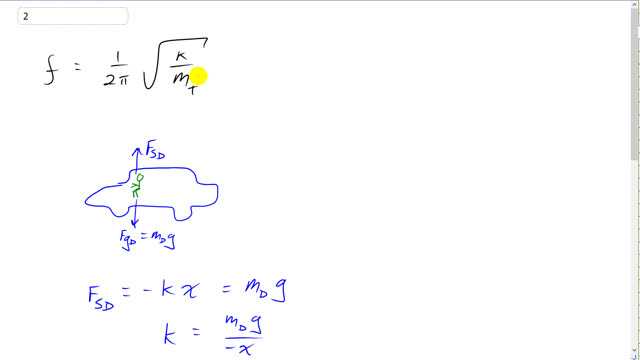
The springs of a 1700-kg car compress 5.0 mm when its 66-kg driver gets into the driver’s seat. If the car goes over a bump, what will be the frequency of oscillations? Ignore damping.

In order to watch this solution you need to have a subscription.
This is Giancoli Answers with Mr. Dychko. The frequency of oscillation of any simple harmonic motion is 1 over 2 π times the square root of the spring constant divided by the mass so, I put mass subscript capital T here to emphasize that it's the total mass. So, it's the mass of the driver plus the car here. And the extra bit of work we have to do in this question is to figure out what the spring constant of the suspension in the car is. So, with this picture here we know that the, when the driver gets in there's going to be a weight downwards on the driver, force of gravity on the driver, mass of the driver times g. And then there's going to be a compensating spring force on the driver upwards. And they can be equal to each other because the, the driver is not going to be accelerating up or down and the spring force on the driver is going to be negative k times the amount that the spring was compressed, x. And then that's going to equal the weight of the driver and so we can solve this for k by dividing both sides by x. And we get k, spring constant, is mass of the driver times g divided by negative x. And x. Well, the spring force is upwards and x is downwards and we could say up is the positive direction in which case x is negative because the spring is being compressed downwards and downwards is the negative number. So, when we plug in for x here, we're going to be plugging in negative 5 millimeters. So, this negative outside times the negative of x itself it's gonna work out to be positive in the end. But let's substitute this k into our formula for frequency and we have frequency is 1 over 2 π times square root mass of the driver times g over negative x divided by the total mass and this we can multiply top and bottom by negative x. Oops. That's confusing, to write a little multiply sign there. And then the negative x there and that denominator cancels with this one and then we're left with negative x in the bottom times the total mass which I expanded into mass driver plus mass car. And so we have frequencies 1 over 2π times 66 kilograms times 9.8 newtons per kilogram divided by negative of negative 5 times 10 to the minus 3 meters, I'm converting the millimeters into meters there, and times by 66 kilograms plus 1,700 kilograms and this gives about 1.4 hertz will be the frequency of oscillation of the car driver system after it goes over any bump. And the bump can be any size because the frequency of oscillation does not depend on the amplitude of the oscillation. You know, within limits of, you know, not bottoming out the suspension and stuff like that.
is there a reason why you divide by -x instead of just positive x in the very beginning of the video? Is it so that the k constant would turn out positive?